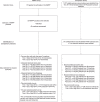Maryland Multipayor Patient-centered Medical Home Program: A 4-Year Quasiexperimental Evaluation of Quality, Utilization, Patient Satisfaction, and Provider Perceptions
- PMID: 29462077
- PMCID: PMC5882272
- DOI: 10.1097/MLR.0000000000000881
Maryland Multipayor Patient-centered Medical Home Program: A 4-Year Quasiexperimental Evaluation of Quality, Utilization, Patient Satisfaction, and Provider Perceptions
Abstract
Objective: To evaluate impact of the Maryland Multipayor Patient-centered Medical Home Program (MMPP) on: (1) quality, utilization, and costs of care; (2) beneficiaries' experiences and satisfaction with care; and (3) perceptions of providers.
Design: 4-year quasiexperimental design with a difference-in-differences analytic approach to compare changes in outcomes between MMPP practices and propensity score-matched comparisons; pre-post design for patient-reported outcomes among MMPP beneficiaries.
Subjects: Beneficiaries (Medicaid-insured and privately insured) and providers in 52 MMPP practices and 104 matched comparisons in Maryland.
Intervention: Participating practices received unconditional financial support and coaching to facilitate functioning as medical homes, membership in a learning collaborative to promote education and dissemination of best practices, and performance-based payments.
Measures: Sixteen quality, 20 utilization, and 13 cost measures from administrative data; patient-reported outcomes on care delivery, trust in provider, access to care, and chronic illness management; and provider perceptions of team operation, team culture, satisfaction with care provided, and patient-centered medical home transformation.
Results: The MMPP had mixed impact on site-level quality and utilization measures. Participation was significantly associated with lower inpatient and outpatient payments in the first year among privately insured beneficiaries, and for the entire duration among Medicaid beneficiaries. There was indication that MMPP practices shifted responsibility for certain administrative tasks from clinicians to medical assistants or care managers. The program had limited effect on measures of patient satisfaction (although response rates were low) and on provider perceptions.
Conclusions: The MMPP demonstrated mixed results of its impact and indicated differential program effects for privately insured and Medicaid beneficiaries.
Conflict of interest statement
The authors declare no conflict of interest.
Figures
References
-
- Beasley C. The triple aim: optimizing health, care, and cost. Healthc Exec. 2009;24:64–66. - PubMed
-
- National Committee for Quality Assurance. NCQA patient-centered medical home: improving experiences for patients, providers and practice staff. Available at: http://www.ncqa.org/Portals/0/Programs/Recognition/PCMH/PCMH-2014_Brochu.... Accessed February 8, 2018.
-
- Takach M. About half of the states are implementing patient-centered medical homes for their Medicaid populations. Health Aff (Millwood). 2012;31:2432–2440. - PubMed
-
- Edwards ST, Bitton A, Hong J, et al. Patient-centered medical home initiatives expanded in 2009–13: providers, patients, and payment incentives increased. Health Aff (Millwood). 2014;33:1823–1831. - PubMed
-
- Jackson GL, Powers BJ, Chatterjee R, et al. Improving patient care. The patient centered medical home. A systematic review. Ann Intern Med. 2013;158:169–178. - PubMed
MeSH terms
LinkOut - more resources
Full Text Sources
Other Literature Sources


